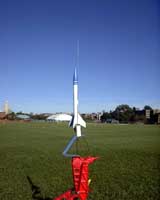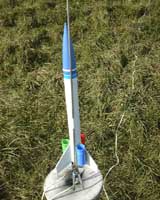I bought this kit in the hopes that it would make a good parachute duration flyer for my NARTREK Bronze. It took several tries but eventually worked. Assembley was exceptionally easy. I used CA for all of the adhesive connections except the fin fillets, which were made with wood glue. This was the first rocket for which I found the default paint/decal scheme acceptable. However, I found the decals to be a major letdown. They aren't water decals like Estes rockets; they were stickers. And as stickers they were far too thick. In particular, the body tube sticker with the name of the rocket on it is not bendable enough to stay stuck to the tube. I may have to remove it alltogether as it is coming up on the sides despite a healthy coating of clearcoat over the top. The plastic parachute that comes with this kit was somewhat puny, so I replaced it with a 12" nylon chute from Aerotech. This chute suffered some minor damage during its second flight but is still useable. I tried stuffing a 24" chute into it for a NARTREK duration flight, but it got tangled on the first try and caused the rocket to separate on the next. I was able to get the required 60 seconds out of the 12" nylon chute eventually. Before the October 20, 2001 launch, I glued three cylindrical siren whistles onto the body tube of the rocket as a test platform for a future "Sounding Rocket" that I want to build. This became the technology testbed for that design. During that launch the shock cord attachment point on the nosecone broke and had to be replaced. This repair took place on November 2nd. Sporting its new magenta nosecone, the rocket demonstrated on November 3rd that it takes a C motor to get the sirens spinning in their configuration next to the body tube. The shock cord separated on the last test and the new nosecone and old parachute floated away never to be seen again. After the fourth siren test, I wanted to do some testing with the sirens on the fin tips rather than against the body tube. I detached the whistles from the Astra I and tried to sand down the fin tips so that I could get a good strong glue joint. My sanding job ended up being too effective and a little un-level. By the time I had all three tip chords parallel to the body tube and all three semispans equal, the fins had been ground down so far that the rocket looked like it might not be stable. Rather than replace the fins on this rocket that now had the majority of its parts missing or damaged, I choose to retire the rocket and move the siren testing to another vehicle. | ||||||||||||||||||||||||||||||||||||||||||||||||||||||||||||||||||||||||||||||||||||||||||||||||||||||||||||||

